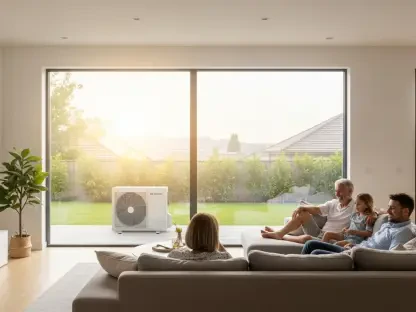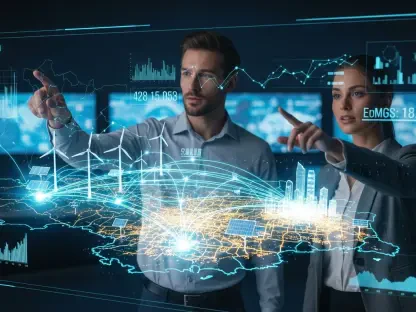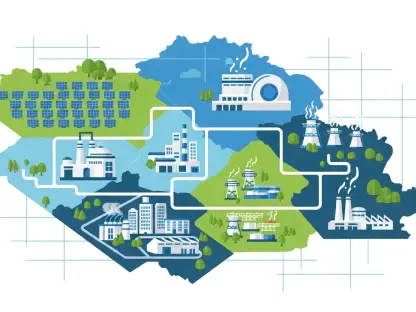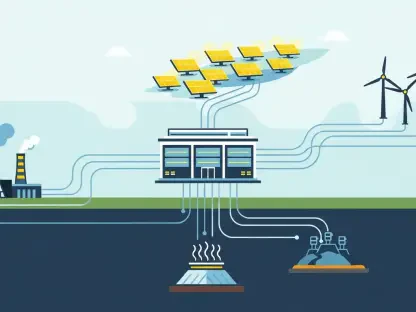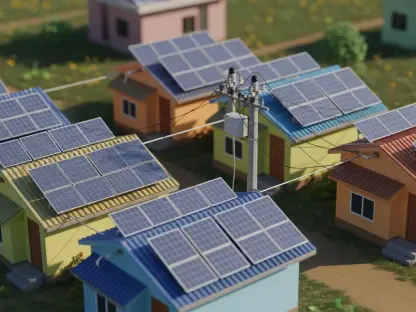Illinois is on the brink of a significant energy transformation. With the introduction of two proposed bills, HB5856 and SB3959, the state is aiming to enhance the reliability of its electric grid, promote renewable energy, and deliver substantial financial savings to ratepayers. These legislative efforts are a cornerstone in Illinois’ ambitious goal of achieving 100% emissions-free electricity by 2050.
The Driving Purpose Behind the Legislation
Mandate for Clean Energy Storage
The primary purpose of HB5856 and SB3959 is to mandate a considerable increase in clean energy storage procurement. This effort is crucial for modernizing Illinois’ aging power infrastructure and removing obstacles to the deployment of renewable energy sources. By doing so, the bills aim to set a clear pathway toward a more resilient and resourceful energy grid.
By setting forth a mandate that seeks to revolutionize the energy storage landscape within the state, these pieces of legislation are poised to transform Illinois’ approach to energy production and consumption. Integrating large-scale and decentralized energy storage systems will enhance grid stability, ensuring that power remains reliable even amid fluctuating supply and demand scenarios. Furthermore, the focus on renewables will cut down on carbon emissions, directly contributing to Illinois’ broader commitment to a cleaner, greener future. These measures will help overcome the significant barriers that have historically hindered the integration of renewable energy sources, such as the unpredictability and intermittency of solar and wind power.
Targets and Technologies
The legislation outlines an ambitious target: procure 8.5 gigawatts (GW) of energy storage statewide by 2050. This target includes a variety of scales and technologies, from utility-scale batteries to behind-the-meter storage solutions, thus ensuring a holistic approach to grid modernization.
The inclusion of diverse energy storage technologies aims to leverage the strengths of each type. Utility-scale batteries can store large amounts of energy generated from renewable sources, ensuring that it can be redistributed during times of high demand or lower production. Behind-the-meter solutions, on the other hand, empower consumers to manage their own energy usage more effectively, reducing strain on the grid and lowering costs. This comprehensive approach underlines the legislators’ commitment to making Illinois a leader in energy storage and renewable energy adoption. Meeting this ambitious target will require not only significant investment and technological innovation but also robust regulatory frameworks that support growth in the clean energy sector.
Financial and Economic Implications
Consumer Savings and Economic Benefits
The implementation of these bills is projected to yield significant financial benefits for consumers. Illinois ratepayers could potentially save up to $30 per month on their energy bills. In aggregate, the bills promise $3 billion in cost savings for consumers, $7 billion in avoided blackout expenses, and an injection of $16 billion into the state’s economy by 2050.
Cost savings for consumers are a major selling point for these legislative initiatives. By reducing monthly energy bills, the bills offer immediate financial relief for households across the state. This comes at a time when energy costs are rising nationwide, exacerbated by issues like grid inefficiencies and the increasing prices of traditional fossil fuels. The proposed savings illustrate the practical benefits of transitioning to a more efficient and sustainable grid, making the legislative push not only an environmental imperative but an economic one as well.
Economic Growth and Job Creation
In addition to consumer savings, the proposed legislation is set to catalyze economic growth and job creation. The clean energy sector is poised for expansion, offering numerous career opportunities in renewable energy and grid modernization. This growth could make Illinois a hub for clean energy innovation and skilled labor.
Fostering economic growth through investment in clean energy infrastructure carries long-term benefits that extend beyond job creation. As new businesses emerge and existing ones expand to meet the demand for clean energy solutions, the state’s economy stands to gain significantly. Additionally, developing a robust clean energy workforce can position Illinois as a leader in the national and global energy markets. This growth is expected to benefit communities across the state, including those previously reliant on fossil fuel industries, by providing new, sustainable jobs and reducing economic disparities.
Enhancing Grid Reliability
Addressing Grid Resilience
One of the critical objectives of the proposed bills is to enhance the reliability of Illinois’ electric grid. By integrating energy storage solutions, the grid’s capacity to manage peak loads and reduce reliance on non-renewable energy during high-demand periods will be significantly improved. This enhancement aligns perfectly with the state’s climate goals.
Improving grid resilience through energy storage is pivotal in ensuring that power availability remains steady and reliable. Energy storage systems can absorb excess electricity generated during off-peak times and discharge it when demand peaks, thereby leveling the load on the grid. This balancing act reduces the likelihood of outages and avoids the need to activate expensive, carbon-intensive peaker plants. The move towards a smarter, more adaptive grid infrastructure will also make it easier to integrate additional renewable energy sources in the future, further bolstering Illinois’ environmental and economic objectives.
Virtual Power Plants and Energy Storage Ecosystem
The bills aim to establish a robust ecosystem for energy storage and Virtual Power Plants (VPPs). This initiative would help in decreasing dependency on non-renewable fuels during peak usage times, further supporting Illinois’ target of 100% emissions-free electricity.
Creating an ecosystem that includes Virtual Power Plants signifies a forward-thinking approach to energy management. VPPs aggregate multiple energy sources and storage systems to function as a unified entity, thereby optimizing the generation, storage, and distribution of electricity. This technology allows for more dynamic and efficient utilization of renewable energy, helping to reduce costly and carbon-heavy reliance on conventional power plants. By integrating VPPs into the state’s energy landscape, Illinois can create a more flexible and resilient grid capable of meeting future demands while adhering to stringent emissions targets.
Addressing Interconnection Challenges
Reforming Interconnection Processes
Current interconnection processes in Illinois are riddled with unpredictability and high costs, often stalling or terminating renewable energy projects. HB5856 and SB3959 propose reforms to streamline these processes, offering greater transparency and reducing unexpected costs. These reforms will ensure the safety and integrity of the grid while facilitating smoother integration of new energy sources.
The reforms proposed in the bills aim to simplify and standardize the interconnection processes, making it easier for renewable energy projects to come online. Currently, the unpredictability in interconnection can lead to significant delays and increased costs, which deter investors and slow the transition to clean energy. By implementing a more transparent and predictable framework, these bills can help remove one of the major barriers facing renewable energy developers. This would not only accelerate the deployment of clean energy projects but also reduce operational risks and costs associated with connecting to the grid.
Financial and Operational Predictability
The proposed reforms aim to make the process more predictable, thereby fostering a conducive environment for the development of renewable energy projects. By reducing regulatory and financial barriers, the legislation will pave the way for more efficient and cost-effective project implementation.
Creating a more predictable interconnection process helps developers and utilities plan more effectively, thereby lowering project costs and timelines. This kind of regulatory stability is crucial for attracting investment in renewable energy. When developers can accurately forecast project costs and timelines, they are more likely to proceed with investments, knowing that the financial risks are minimized. This will ultimately lead to a more rapid and widespread adoption of renewable energy technologies, reinforcing Illinois’ commitment to achieving a clean energy future.
Immediate and Long-Term Benefits
Addressing Immediate Energy Needs
Senator Bill Cunningham (D-Chicago) emphasized the urgency of meeting immediate energy deadlines to avoid stalling the state’s journey towards a 100% emissions-free grid. The legislation addresses these imminent needs by setting short-term milestones that align with long-term climate goals.
Meeting immediate energy needs is vital for maintaining the momentum towards Illinois’ emission-free ambitions. By setting clear, achievable milestones, the proposed legislations ensure that both short-term actions and long-term strategies are aligned. This approach enables Illinois to make consistent, measurable progress toward its climate goals while addressing urgent gaps in the current energy system. The focus on immediate actions also underscores the importance of not delaying critical energy reforms, as each step toward cleaner energy contributes to overall resilience and sustainability.
Economic Feasibility
Mark Pruitt’s study underscores the economic feasibility and benefits of the proposed energy storage targets. The incentives for adopting technologies that reduce peak loads and integrate storage with solar and wind developments are expected to catalyze widespread adoption, making the legislative targets not only ambitious but also achievable.
The study highlights that the proposed targets for energy storage not only make environmental sense but are also economically viable. The incentives incorporated within the bills are designed to accelerate the adoption of cutting-edge technologies that can reduce operational costs and enhance grid stability. By integrating storage solutions with renewable energy sources, Illinois can create a more efficient and cost-effective energy system that offers significant returns on investment. The economic feasibility of these targets ensures that they are not merely aspirational but practically achievable, promoting long-term sustainability and economic health.
Conclusion
Illinois is on the cusp of a groundbreaking energy shift with the introduction of two pivotal bills, HB5856 and SB3959. These legislative measures are designed to improve the reliability of the state’s electric grid, advance the adoption of renewable energy sources, and provide significant cost savings to ratepayers. The proposed bills aim to modernize the state’s energy infrastructure, making it more resilient against outages and reducing dependence on fossil fuels.
As part of these efforts, Illinois is also focusing on increasing investments in wind, solar, and other clean energy technologies. This multi-faceted approach is essential for meeting the state’s ambitious target of attaining 100% emissions-free electricity by 2050. Additionally, by focusing on renewable energy, Illinois hopes to attract new businesses and create job opportunities in the green energy sector.
Overall, these legislative efforts are a critical piece of Illinois’ broader strategy to combat climate change, ensure energy security, and facilitate a smoother transition to a sustainable future. With these bills, the state aims to set a precedent for environmental stewardship and economic growth in the renewable energy landscape.




